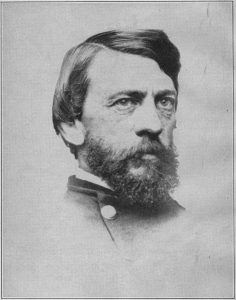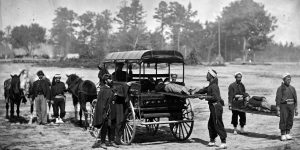Jonathan Letterman changed the course of the Civil War and of American medicine. His innovation and retooling of the Union Army’s Medical Corps during the chaotic battles of 1862 make him a hero of Civil War medicine. Letterman’s achievements during the bloodiest day in American history at Antietam on September 17, 1862 are highlighted at the National Museum of Civil War Medicine and his headquarters on the battlefield at the Pry House Field Hospital Museum.
Meet the Medical Director
Letterman became the Medical Director of the Army of the Potomac in July 1862. When Letterman took command, the Civil War had been raging for more than a year. Letterman had distinguished himself during a long career as a U.S. Army surgeon since his graduation from Jefferson Medical College in 1849.

Prior to Letterman’s arrival on the scene in 1862, the Army of the Potomac’s medical corps was a mess. His selection as Medical Director for the most important Union army in the field represented a censure of the former medical officers who held the post during the first year of the war. They had largely failed in their duty to adequately care for those wounded on the battlefield and those sick in the hospitals. At the Battle of First Bull Run in July 1861, many wounded were left on the battlefield to suffer for days in the hot sun. The ambulance system of the United States Army had failed them.
Letterman arrived at a crucial time in the Civil War. By the end of August, the Union army was on the retreat again from Bull Run. General Robert E. Lee and his Army of Northern Virginia began crossing the river into Union-controlled Maryland. The stage was set for the biggest challenge of Jonathan Letterman’s life.
Antietam and Ambulances
His first task was to bring all of the medical supplies and ambulances from their base on the Virginia Peninsula to the future battlefields of Maryland. This required bring everything up the Chesapeake Bay from Fortress Monroe to Washington and Baltimore. Once the supplies were there, Letterman had revolutionary ideas for the usage during the battles to come.

He planned a reorganization of the ambulance corps which had performed poorly in earlier campaigns, often being used to haul supplies instead of those needing emergency medical care. Once the wounded were brought in, Letterman sketched out a tiered-system of care to evaluate and treat each patient.
Letterman was creating the first dedicated ambulance service in the United States Army. His surgeons now had a plan to triage the wounded, striving to give them the best possible chance to survive and to rejoin the fight after recuperation. And he was creating a triage system and evacuation plan all in the midst of a massive military campaign involving hundreds of thousands of soldiers on the march.
When two great armies met on the rolling ground along the banks of Antietam Creek on September 17, Letterman and his surgeons were prepared. In the bloodiest single day of the Civil War, the Union and Confederate armies engaged in horrific combat, leaving behind a landscape of death and suffering. The Medical Corps was faced with 17,000 wounded scattered across miles of Western Maryland. They performed admirably considering the circumstances and removed all wounded from the battlefield within 24 hours, an incredible feat considering the department’s previous performance.
The efficient treatment of the wounded at the Battle of Antietam is celebrated as one of Letterman’s greatest triumphs and a huge innovation for the Army, however, that does not mean it was perfect. Surgeons and hospitals, particularly those on the battlefield, were plagued by the lack of medical supplies. When Clara Barton arrived at one field hospital to help nurse the wounded, she was shocked to discover that the hospital had run out of bandages and was using corn leaves to cover open wounds.
The Letterman Plan
Not satisfied with the shortcomings of Army’s Medical Corps, Letterman would continue to reorganize the Army’s system of trauma care, dedicated to improving the treatment and chance of survival of wounded warriors. These changes, ordered in October 1862, are known as The Letterman Plan. The plan ensured that wounded soldiers would be cared for from the moment they were injured all the way through long term recovery.
If a soldier was wounded, they would be treated first just behind the front lines at a Field Dressing Station. Once all bleeding was stopped, the soldier would be sent via ambulance to a field hospital set up a bit further behind the lines where major surgery took place if needed. Once the soldiers was well enough to be moved, they would be sent back to larger general hospitals located in major cities for long term recovery.
Additionally, Letterman reorganized military hospitals. Every military hospital would have would have one surgeon in change, with two assistant surgeons: one to organize supplies and another to keep records. In addition to these three surgeons, hospitals would choose the three most skilled medical officers, as opposed to the three highest ranking, to operate. Letterman also made sure that the regular Army quartermaster was no longer in charge of medical supplies.
The policies put in place by Letterman were important in caring for the wounded in the many bloody battles to come. He personally oversaw the Medical Corps’ response to the battles of Fredericksburg, Chancellorsville, and Gettysburg.
“I often wondered whether, had I been confronted with the primitive system which Letterman fell heir to at the beginning of the Civil War, I could have developed as good an organization as he did. I doubt it. There was not a day during World War II that I did not thank God for Jonathan Letterman.”
– Major General Paul Hawley, Chief Surgeon of the European Theater in WWII
Letterman’s Legacy
Jonathan Letterman resigned from his position as Medical Director in January 1864. His “plan” lived on, however, as law. In March 1864, the United States Congress implemented Letterman’s changes across the entire United States Army. They remain today, a basis for our military’s modern network of emergency treatment and hospitals for wounded warriors.
This post is part of the Real Characters of Mercy Street series.


